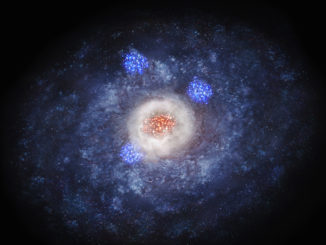
Subaru Telescope



Explosive birth of stars can swell galactic cores
Astronomers have found that active star formation upswells galaxies, like yeast helps bread rise. Using three powerful telescopes on the ground and in orbit, they observed galaxies from 11 billion years ago and found explosive formation of stars in the cores of galaxies. This suggests that galaxies can change their own shape without interaction with other galaxies.



Record-breaking dwarf satellite galaxy of the Milky Way discovered
An international team has found an extremely faint dwarf satellite galaxy of the Milky Way using the Hyper Suprime-Cam (HSC) on the 8.2-metre Subaru Telescope located at the Mauna Kea Observatory on Hawaii. Named Virgo I, the galaxy lies 280,000 light-years away in the constellation of Virgo. The galaxy may well be the faintest satellite galaxy yet found.

Earth-bound CHARIS samples atmospheric gases of exoplanets
A team of scientists and engineers led by Princeton University researchers recently reported the successful operation of a new instrument for the 8.2-metre Subaru Telescope at the Mauna Kea Observatory on Hawaii that will allow astronomers to make direct observations and take spectra of planets orbiting nearby stars.

Using oxygen as a tracer of galactic evolution
A new study comprised of 7,000 galaxies casts light on how young, hot stars ionise oxygen in the early universe and the effects on the evolution of galaxies through time. The study presents the first measurements of the changing strengths of oxygen emission lines from the present day and back to 12.5 billion years ago.

Newly discovered distant solar system objects resonate with Neptune
The search for distant solar system objects has found two more small worlds far outside the orbit of Neptune, beyond the Kuiper Belt. The new objects, 2014 FZ71 and 2015 FJ345, are in resonance with Neptune’s orbit, implying that these worlds either have interacted with Neptune in the past or are continuing to do so.

A team of super bright galaxies in the early universe
In 2015, Dr. David Sobral of Lancaster University led a team that found the first example of a spectacularly bright galaxy in the young universe named CR7 which may harbour first generation stars. Now, astronomers have identified a family of incredible galaxies that could shed further light on the transformation of the early universe known as the “epoch of reionisation.”
